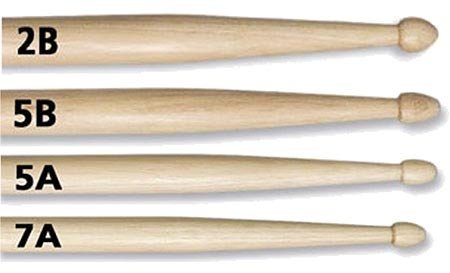Whether you’re just starting out or looking to refine your sound, finding the right drumsticks can significantly impact your performance. Drumsticks aren’t just about hitting the drums; they shape your sound, control, and comfort. Let’s dive into the essentials you need to consider to find the perfect pair.

1. Understanding Numbers and Letters on Drumsticks
Drumsticks are labeled with numbers and letters, such as 5A or 7B, which refer to their size and purpose:
- Number: Represents the thickness; lower numbers (like 2) mean thicker, heavier sticks that are ideal for powerful playing. Higher numbers (like 7) indicate thinner, lighter sticks for finesse and precision.
- Letter: Indicates the original intent of the stick:
- A (e.g., 5A): Made for orchestral music but often used in lighter, jazz settings.
- B (e.g., 2B): Heavier and more durable, popular in rock and marching bands.
- S (e.g., 5S): The thickest option, originally made for marching bands, producing high volume.
2. Selecting the Right Material
Drumsticks come in several types of wood, each offering unique characteristics in feel and durability:
- Hickory: The most commonly used, hickory provides a good balance between durability and shock absorption, making it versatile for various styles.
- Oak: Oak is dense and heavy, producing a robust sound with less vibration absorption. These sticks are great for hard-hitting styles, such as rock and metal.
- Maple: A lighter wood, maple is easy to maneuver and is popular in genres that prioritize speed, like jazz.
3. Choosing the Right Tip Shape and Material
The shape and material of the tip affect the sound you produce:
- Tip Shapes:
- Round: Offers a focused sound, especially on cymbals, making it ideal for clean and precise playing.
- Oval and Teardrop: These shapes provide a fuller, warmer tone, well-suited for drum-heavy styles.
- Tip Materials:
- Wood Tips: Deliver a warm, natural sound and are favored for their organic feel.
- Nylon Tips: Last longer than wood and create a brighter sound on cymbals, ideal for drummers who need durability and clarity.
4. Length and Diameter: Finding Your Fit
Length and diameter influence both the sound and how comfortable the sticks feel:
- Length: Longer sticks (over 16 inches) provide more reach and leverage, which is useful for rock and metal. Shorter sticks allow for more control, making them a favorite among jazz and funk drummers.
- Diameter: Thicker sticks (like 2B) offer a stronger grip and produce more power, while thinner sticks (like 7A) provide more control and are easier to play at faster tempos.
5. Experiment and Find Your Match
The best way to find the right pair is to try them out! Visit a music store and feel the weight, grip, and balance of different pairs. Testing them on a practice pad or drum kit can help you understand how each type of stick responds to your playing style. Many brands even offer sample packs that include different types, so you can find the one that feels just right.
.
Final Thoughts
Finding the right drumsticks is a personal journey influenced by your style, genre, and comfort. By experimenting with different types, you can find the sticks that best enhance your sound and control.
For detailed insights on drumstick heads, types, and grip techniques, check out the guide at Yamaha
For more of an in-depth review of drumsticks and the process of choosing one go to Sweetwater
For a concise summary combining the highlights from the two articles above, check out this resource Drum Magazine
With the right drumsticks in hand, you’re well on your way to a better playing experience.
Don’t miss our PICKLE PERFECT selection of drum accessories to meet all your drumming needs!
